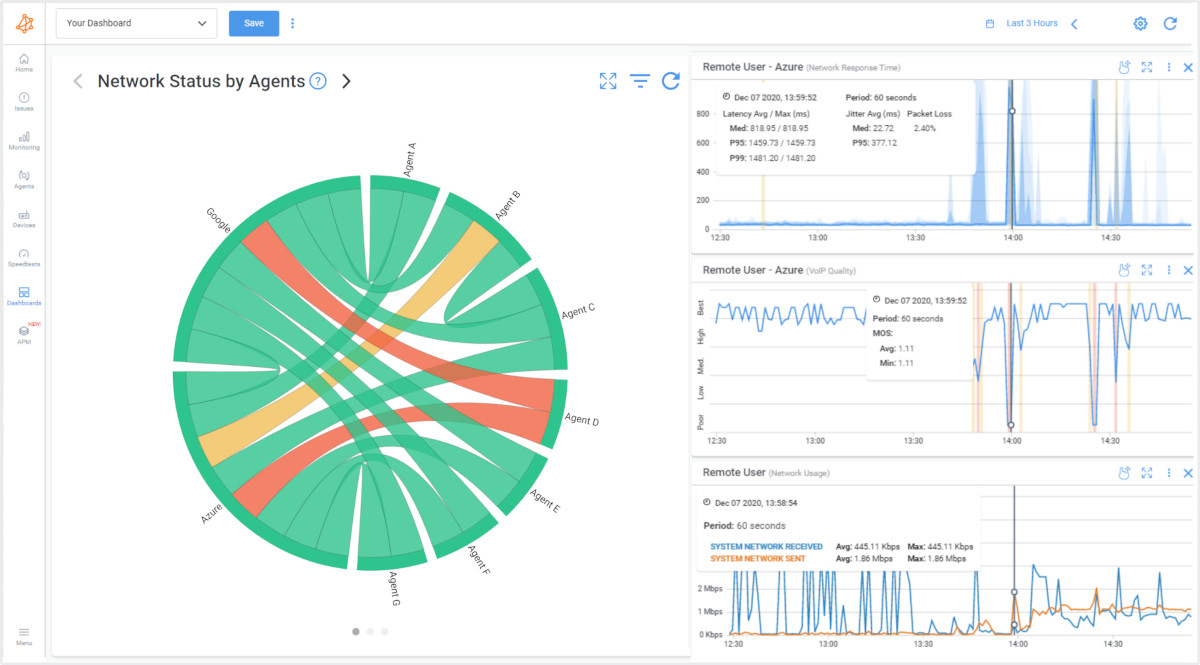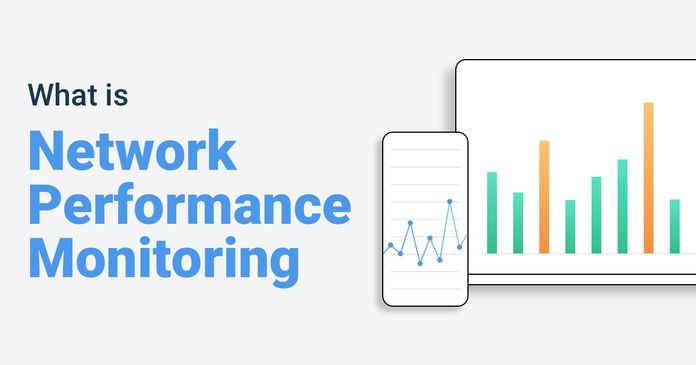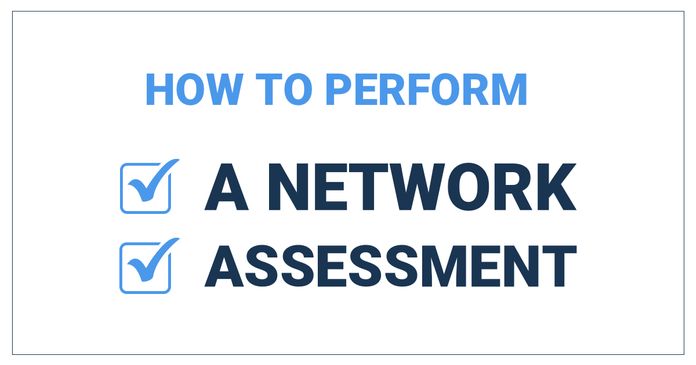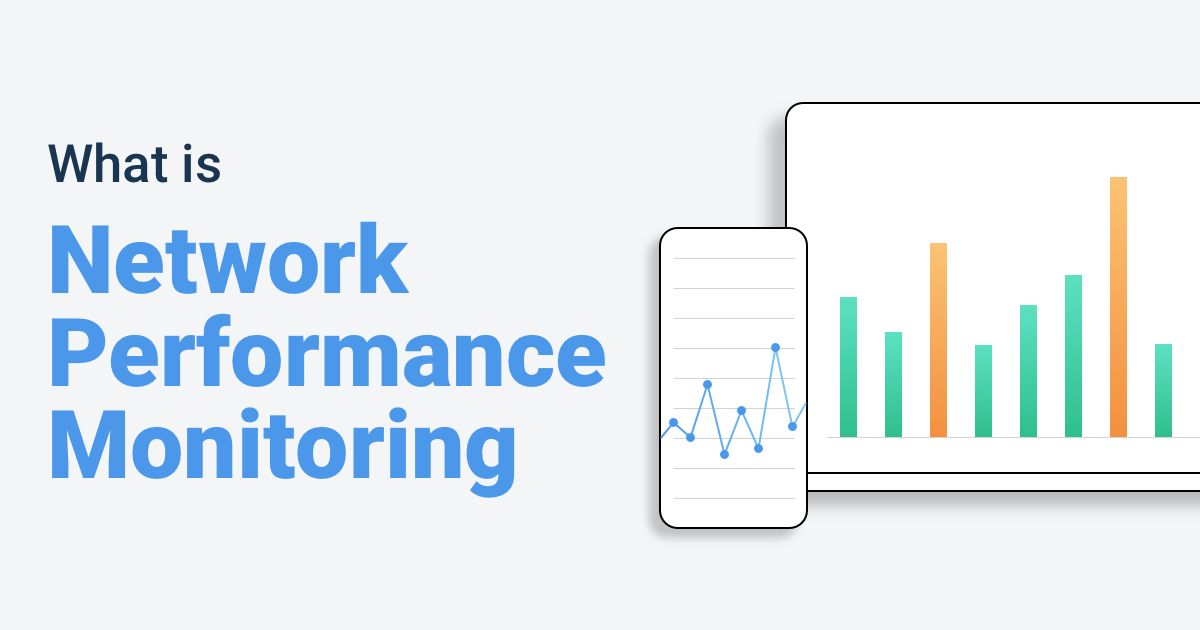Table of Contents
Table of Contents
Every IT administrator knows that users typically complain of two things: the network doesn’t work or it’s slow. When your network isn't working, it’s usually because something is down and we can rely on Network Fault Monitoring tools to notify us.
But where do we start when users complain of poor performance? And what tools are available to help us? In these situations, Network Performance Monitoring tools might be just what you need.
Knowledge is power. We all know that. And when you’re tasked with managing a network, this statement is truer than ever.
You need to know what’s going on at all times. But the problem with networks is that you can’t readily see what’s going on. It all happens at blazing speeds within copper wires or glass fibres.
This is when monitoring tools come in handy.
However, with so many different types of monitoring tools available, each with their pros and cons, picking the right one for your specific situation can turn out to be a challenge.
We'll be comparing two popular types of network monitoring, Network Fault Monitoring and Network Performance Monitoring. Our goal is to compare them, but also emphasize how different they are. So different indeed that they are not mutually exclusive and can even be thought of as complementary.
With one of them centralized and the other distributed, they provide a vastly different kind of insight, a different point of view.
When it comes to monitoring, it seems like everyone has his own idea of what it is, or what it should be.
Fortunately, this is not so much the case with Network Fault Monitoring and pretty much everyone agrees on what it is.
Network Fault Monitoring is a process or system that involves monitoring and detecting faults or abnormalities in a computer network. It aims to identify and address network issues promptly to ensure the smooth operation of the network and minimize downtime.
The primary purpose of network fault monitoring is to proactively identify and resolve problems in the network infrastructure. It involves monitoring various network components such as routers, switches, servers, firewalls, and other devices to detect any anomalies or deviations from normal operation.
Some common network faults that monitoring systems aim to identify include:
- Connectivity issues: This includes detecting network outages, link failures, or intermittent connection problems.
- Performance degradation: Monitoring systems can identify network bottlenecks, high latency, packet loss, or slow response times.
- Device failures: Fault monitoring helps in identifying hardware or software failures in network devices such as routers or switches.
- Security breaches: Monitoring systems can detect unauthorized access attempts, unusual network traffic patterns, or potential security breaches.
- Configuration errors: Identifying misconfigurations or improper settings in network devices that can lead to network disruptions or network disconnections.
Network fault monitoring typically involves the deployment of monitoring tools or software that collect data from network devices in real-time. These tools often use techniques such as SNMP (Simple Network Management Protocol), ICMP (Internet Control Message Protocol) ping tests, flow analysis, and log analysis to monitor network health and identify faults.
When a fault or anomaly is detected, the monitoring system generates alerts or notifications to network administrators or operators. These alerts provide information about the nature of the fault, its severity, and its potential impact on the network. Network administrators can then take appropriate actions to diagnose and resolve the issue, ensuring the network operates optimally.
The process involves:
- Maintaining and examining error logs
- Receiving and processing error notifications
- Tracing and identifying faults
- And carrying out network diagnostic tests
There are two main types of Network Fault Monitoring: Active and Passive.
Passive Network Fault Monitoring works by collecting alerts from networking devices (often sent using SNMP traps) which are raised whenever something abnormal happens.
This type of Network Fault Monitoring relies on the networking devices themselves to identify faults and notify a centralized monitoring system.
In a way, a passive Network Fault Monitoring system is simply a glorified notification system that can send various types of notifications based on the detected faults.
The main drawback of such systems is that a complete failure of a piece of equipment will often result in its inability to send out an alert and the problem might fail to be quickly detected.
Unlock the secrets of network monitoring basics in this article. Dive into everything you need to get started with ease – it's not rocket science!
Learn more

Active Network Fault Monitoring was invented to address the shortcomings of the passive approach. Instead of relying on devices to report faults, it actively (hence the name) monitors them.
It will, for instance, use ping to ensure that devices are up and that they can be reached, and raise an alarm whenever something abnormal is detected such as, a device that no longer responds.
It is just as centralized as passive Network Fault Monitoring - as all tests are typically performed from the centralized monitoring system.
The best type of Network Fault Monitoring is, of course, one that combines both active and passive Network Fault Monitoring approaches, which can provides several advantages for effective network management. Here are some key advantages of implementing fault monitoring:
- Proactive issue detection: Network fault monitoring allows for the proactive detection of network issues and abnormalities. By continuously monitoring network devices and infrastructure, it helps identify faults in real-time or even before they cause significant disruptions.
- Reduced downtime: By promptly identifying and addressing network faults, network fault monitoring helps minimize network downtime. It enables network administrators to quickly diagnose the root cause of an issue and take appropriate actions to resolve it.
- Improved troubleshooting: Network fault monitoring systems provide valuable insights into the network's health and performance. This information aids in troubleshooting efforts by narrowing down the problem's scope and accelerating the resolution process.
- Enhanced network performance: Fault monitoring helps in identifying performance bottlenecks, congestion points, or other issues affecting network performance. By monitoring key metrics like bandwidth utilization, latency, and packet loss, administrators can identify areas that require optimization or capacity upgrades.
- Predictive maintenance: Network fault monitoring systems, when integrated with predictive analytics, can provide insights into potential issues before they occur. By analyzing historical data and patterns, these systems can identify trends that indicate future problems or failures.
While network fault monitoring offers numerous benefits, there are also some potential disadvantages associated with its implementation. Here are a few:
- False alarms: Network fault monitoring systems can generate false alarms, indicating network issues when there are none. This can be caused by misconfigurations, temporary glitches, or monitoring tool inaccuracies. False alarms can lead to alert fatigue and reduced trust in the monitoring system, causing administrators to ignore or overlook genuine issues.
- Overwhelming alerts: In large networks or environments with numerous devices, network fault monitoring systems can generate a high volume of alerts. Sorting through and prioritizing these alerts can be challenging, particularly when dealing with limited resources. It may result in delayed response times or a failure to address critical issues promptly.
- Complexity and learning curve: Implementing and managing a network fault monitoring system can be complex, especially for organizations with limited network management expertise. Setting up the system, configuring thresholds, and interpreting the monitoring data may require specialized knowledge. There may be a learning curve involved in becoming proficient with the monitoring tools and effectively utilizing the information provided.
- Resource consumption: Network Fault monitoring systems continuously monitor network devices, collecting data and generating alerts. This process consumes system resources such as CPU cycles, memory, and network bandwidth. In some cases, the monitoring system itself can contribute to network congestion, network overload or resource contention, affecting overall network performance.
- Cost implications: Deploying and maintaining a robust network fault monitoring system can incur significant costs. This includes the acquisition of monitoring tools or software licenses, hardware infrastructure, and ongoing maintenance and support. Small organizations with limited budgets may find it challenging to invest in comprehensive fault monitoring solutions.
- Incomplete visibility: While network fault monitoring systems can monitor network devices, they may not provide complete visibility into the network infrastructure. Some devices or network segments might be inaccessible or unsupported by the monitoring tools, leaving blind spots where faults can occur undetected.
- Reactive approach: Network fault monitoring is primarily focused on detecting and addressing network issues after they have occurred. While it helps in prompt issue resolution, it does not prevent the occurrence of faults. Organizations may need to complement fault monitoring with proactive measures such as network performance optimization, preventive maintenance, and regular audits to minimize the occurrence of faults.
Learn about network performance monitoring to optimize network performance. Discover key network metrics, tools & techniques & the benefits for businesses.
Learn more

As much as Network Fault Monitoring was clearly defined, things are not so clear with Network Performance Monitoring (also called NPM).
Network Performance Monitoring or NPM refers to the end-to-end monitoring of network performance and end-user experience. It differs from traditional monitoring because performance is monitored from the end-user perspective, and is measured between two points in the network.
For example:
- The performance between a user, who works in the office, and the application they use in the company’s data center
- The performance between two offices in a network
- The performance between the head office and the Internet
- The performance between your users and the cloud
The goal of network performance monitoring is to ensure that the network is operating efficiently and effectively and to identify and address both network availability issues (hard issues) or network performance issues (soft issues) that may arise. This typically involves collecting data on network traffic, bandwidth, latency, and packet loss, and other key network metrics, as well as using various tools and techniques to analyze and interpret this data.
Some vendors of bandwidth usage monitoring tools will claim their tool is a Network Performance Monitoring tool. To a certain extent, they are right.
After all, available bandwidth is a valid measure of a network’s performance. But there are other network metrics that you should also be measuring.


Like with Fault Monitoring, there are also various different types of Network Performance Monitoring that use different performance monitoring techniques to measure network performance and identify network issues.
Some of those types include:
- Passive Network Performance Monitoring Tools: Passive network performance monitoring tools collect and analyze data on network traffic as it flows through the network.
- Active Network Performance Monitoring Tools: Active network performance monitoring tools monitor network performance by sending data packets across the network to simulate user traffic and test network performance.
- SNMP-Based Network Monitoring Tools: SNMP-based network monitoring tools use the Simple Network Management Protocol (SNMP Network Monitoring) to monitor and manage network devices.
- Application Performance Monitoring (APM) Tools: Application Performance Monitoring (APM) tools are software programs designed to monitor the performance and availability of applications in real-time.
- Synthetic Network Performance Monitoring Tools: Synthetic Network Performance Monitoring tools are designed to simulate user behavior on a network to measure network performance.
- Network Packet Analyzer Tools: Network packet analyzers, also known as packet sniffers, protocol analyzers, or network analyzers, capture and analyze the data packets sent and received over a network.
- Flow-Based Network Monitoring Tools: Flow-based network monitoring tools collect information about network traffic by analyzing flow data.
A network performance monitoring tool works by continuously monitoring various aspects of a computer network to assess its health, performance, and availability. The tool collects data from network devices, analyzes the information, and provides administrators with insights and metrics related to network performance.
Regardless the type of Network Performance Monitoring tool you choose, there are certain similarities in the way the NPM tools work:
- Data Collection: The monitoring tool interacts with network devices and infrastructure to gather relevant data. It can use Synthethic Traffic, protocols like Simple Network Management Protocol (SNMP), flow-based protocols (e.g., NetFlow, sFlow), packet analysis, or other methods to collect data. The tool collects information such as bandwidth utilization, latency, packet loss, device CPU usage and memory usage, error rates, and other performance metrics.
- Data Analysis: Once the monitoring tool collects the network data, it analyzes the information to generate meaningful insights and metrics. This analysis can involve evaluating historical trends, comparing current performance against predefined thresholds, identifying patterns, and detecting anomalies or deviations from normal behavior. The analysis may also include correlating data from multiple devices or segments to provide a holistic view of network performance.
- Visualization and Reporting: Network performance monitoring tools present the analyzed data in user-friendly dashboards and reports. These visualizations can include charts, graphs, tables, and other representations that provide a clear overview of the network's performance. Administrators can access real-time or historical data, drill down into specific devices or metrics, and customize the display based on their requirements. The reporting feature enables the generation of regular reports for monitoring network health, SLA compliance, or historical performance analysis.
- Alerting and Notifications: Network performance monitoring tools incorporate alerting mechanisms to notify administrators about potential issues or deviations from normal performance. Administrators can configure thresholds for various metrics, and when those thresholds are exceeded or specific conditions are met, the monitoring tool generates alerts. Alerts can be sent via email, SMS, or other notification channels to inform administrators about critical events, allowing them to take prompt action.
- Troubleshooting and Root Cause Analysis: When performance issues occur, network performance monitoring tools provide valuable insights for troubleshooting and root cause analysis. The tool can help identify the specific device, link, or segment experiencing performance degradation, and provide relevant data and metrics to aid in problem identification. With this information, administrators can investigate the underlying causes, make informed decisions, and implement appropriate remediation measures.
We often compare networks to highways. After all, there are many similarities between the two.
So, imagine a four-lane highway that has been designed to carry up to 7 600 vehicles per hour. The equivalent of bandwidth monitoring would be counting the vehicles passing a given point. For the purpose of this analogy, let’s say that we’ve counted 3 800 vehicles in an hour. This tells us that our highway is used at 50% of its capacity.
While this is a piece of very useful information, it says nothing about how long a vehicle will take to go from one point to another along that highway.
Some will argue that, knowing that there is ample capacity and knowing the speed limit, travel time can easily be extrapolated. And while it could, it would only be an estimation, not a real figure. It would not, for example, take into account any slowdowns caused, for example, by bad weather or a stalled vehicle somewhere along the way.
The only way to have a real account of how long it takes to go from one point to another is to get into a car and time the ride from the starting to the ending points.
Network Performance Monitoring (NPM) offers several advantages for effectively managing and optimizing computer networks. Here are some key advantages of implementing NPM:
- Real-time visibility: NPM provides real-time visibility into the performance of network devices, applications, and infrastructure. Administrators can monitor key metrics such as bandwidth utilization, latency, packet loss, device performance, and application response times. This visibility allows for prompt identification of performance issues, enabling administrators to take immediate action to resolve them.
- Proactive issue detection: NPM helps in the proactive detection of network performance issues before they escalate and impact users or critical business processes. By continuously monitoring network metrics and comparing them against predefined thresholds, administrators can receive alerts or notifications when performance deviates from the expected baseline. This enables early intervention, reducing the risk of network downtime and user dissatisfaction.
- Rapid troubleshooting and root cause analysis: When performance issues arise, NPM provides valuable data and insights to aid in troubleshooting and root cause analysis. Administrators can quickly identify the specific devices, links, or applications experiencing performance degradation, helping them pinpoint the root cause of the problem. This accelerates the troubleshooting process and minimizes the mean time to repair (MTTR), resulting in faster problem resolution.
- Capacity planning and optimization: NPM facilitates network capacity planning by tracking resource utilization trends and forecasting future requirements. By analyzing historical data, administrators can identify potential bottlenecks, plan for capacity upgrades, and optimize network resources. This proactive approach ensures that the network infrastructure can handle increasing demands, optimizing performance and user experience while minimizing costs.
- Improved network performance and user experience: With NPM, administrators can continuously monitor and optimize network performance, leading to improved user experience. By identifying and addressing performance bottlenecks, administrators can ensure that critical applications and services are delivered efficiently. This enhances productivity, reduces frustration, and enhances customer satisfaction.
- Compliance and reporting: NPM provides detailed performance data, metrics, and reports that are valuable for compliance requirements and reporting. Administrators can generate reports to demonstrate adherence to service-level agreements (SLAs), track compliance with industry standards, and provide evidence for audits. This supports regulatory compliance and enables effective communication with stakeholders.
Overall, Network Performance Monitoring offers significant advantages by providing real-time visibility, proactive issue detection, rapid troubleshooting, capacity planning, improved network performance, enhanced security, and compliance support. By leveraging NPM tools, organizations can optimize their network infrastructure, ensure efficient operations, and deliver a seamless user experience.

So now that we know a little about both monitoring techniques seperately, how do they compare, and which should you use?
Network Fault Monitoring (NFM) and Network Performance Monitoring (NPM) are two key aspects of network management that play distinct but complementary roles. While NFM focuses on identifying and resolving faults or abnormalities that can cause disruptions in the network infrastructure, NPM is dedicated to monitoring and optimizing network performance to ensure efficient operations and a seamless user experience.
- Network Fault Monitoring: NFM primarily focuses on identifying and addressing network faults or abnormalities that can cause disruptions or failures in network infrastructure. It aims to detect and resolve issues that impact network availability and reliability.
- Network Performance Monitoring: NPM focuses on monitoring and optimizing network performance as a whole by tracking key metrics such as bandwidth utilization, latency, packet loss, and application response times. It aims to ensure that the network operates efficiently and delivers a satisfactory user experience, while also identifying and helping to troubleshoot network performance issues.
- Network Fault Monitoring: NFM is designed to identify and address specific faults or failures in the network infrastructure promptly. It helps in minimizing downtime, resolving connectivity issues, and maintaining the overall stability of the network.
- Network Performance Monitoring: NPM is focused on monitoring and optimizing the performance of the network by identifying bottlenecks, optimizing resource utilization, and ensuring efficient delivery of applications and services. It aims to enhance user experience and optimize network efficiency.
- Network Fault Monitoring: NFM typically employs techniques such as SNMP, ICMP ping tests, log analysis, or flow analysis to monitor network devices and detect faults or anomalies. It emphasizes identifying deviations from normal operation and generating alerts when specific fault conditions are met.
- Network Performance Monitoring: NPM uses techniques such as Synthetic Traffic, SNMP Network Monitoring, flow-based protocols, or packet analysis to collect data and analyze network performance metrics. It focuses on tracking performance indicators, comparing them against predefined thresholds, and providing insights into network performance trends and issues.
- Network Fault Monitoring: Key metrics in NFM include connectivity status, device availability, error rates, link failures, hardware or software failures, and security breaches. It aims to detect anomalies or deviations from expected behavior that indicate faults or failures in the network infrastructure.
- Network Performance Monitoring: Key network metrics in NPM include bandwidth utilization, latency, packet loss, application response times, throughput, and resource utilization. It focuses on evaluating network performance, identifying performance bottlenecks, and optimizing resource allocation.
- Network Fault Monitoring: NFM generates network monitoring alerts or notifications when faults or abnormalities are detected. Administrators can then take prompt actions to diagnose, troubleshoot, and resolve the specific network issues identified.
- Network Performance Monitoring: NPM provides insights into network performance, helping administrators optimize resource allocation, identify performance bottlenecks, and proactively address potential issues before they impact user experience. It aids in capacity planning, performance optimization, and proactive network management.
While there is some overlap between Network Fault Monitoring and Network Performance Monitoring, they have distinct focuses and objectives. NFM emphasizes fault detection and resolution to ensure and test network stability, while NPM focuses on monitoring and optimizing performance to enhance user experience and network efficiency. Both approaches are essential for effective network management, and organizations often employ a combination of fault monitoring and performance monitoring tools to maintain a robust and reliable network infrastructure.
Upgrade your network management strategy with Obkio's advanced Network Performance Monitoring tool. Gain comprehensive visibility into your network infrastructure, optimize performance, and deliver a seamless user experience.

With real-time monitoring, proactive alerts, and powerful analytics, Obkio empowers you to go beyond fault detection and focus on optimizing your network's performance. Boost productivity, minimize downtime, and ensure efficient delivery of applications and services.
And unlock the full potential of your network!
- 14-day free trial of all premium features
- Deploy in just 10 minutes
- Monitor performance in all key network locations
- Measure real-time network metrics
- Identify and troubleshoot live network problems

The choice between Network Fault Monitoring (NFM) and Network Performance Monitoring (NPM) depends on the specific needs and objectives of network management. Here are some scenarios that can help determine when to use each technique:
- Immediate fault detection and resolution are crucial: NFM is ideal when the primary concern is quickly identifying and addressing network faults or abnormalities that can cause disruptions, downtime, or connectivity issues. It helps minimize the impact on business operations and ensures network stability.
- Network availability and reliability are paramount: If the main objective is to maintain high network availability and reliability of the network infrastructure, NFM should be employed. It helps detect and resolve issues such as device failures, link failures, security breaches, or other fault conditions promptly.
- Troubleshooting specific network issues: When there are known or suspected faults in the network, NFM can aid in troubleshooting efforts. It helps pinpoint the root cause of issues by generating alerts or notifications that highlight specific devices, connections, or areas experiencing abnormalities.
- Optimizing network performance and user experience is a priority: NPM is valuable when the focus is on monitoring and enhancing network performance to deliver an optimal user experience. It tracks metrics like bandwidth utilization, latency, packet loss, network utilization, and application response times, helping identify and address performance bottlenecks and ensure efficient resource allocation.
- Proactive performance management is required: NPM is beneficial for proactive network performance management. By continuously monitoring performance metrics and comparing them against predefined thresholds, administrators can identify potential issues before they impact users. It aids in capacity planning, performance optimization, and resource allocation to maintain a well-performing network.
- Ensuring efficient delivery of applications and services: If the primary goal is to ensure that critical applications and services are delivered efficiently, NPM is essential. It provides insights into the performance of network-dependent applications, helping administrators optimize network configurations, prioritize traffic, and ensure smooth application delivery.
In practice, both NFM and NPM are often used together as part of a comprehensive network management strategy. NFM addresses immediate faults and stability concerns, while NPM focuses on ongoing performance optimization. The combination of both techniques allows for proactive management, swift issue resolution, and the maintenance of a reliable and high-performing network infrastructure.


Suppose you manage a cloud-based infrastructure which hosts business-critical applications and services.
While Network Fault Monitoring would be useful and notify you if one of the components or systems stopped responding, you probably expect more from your monitoring solution.
A true Network Performance Monitoring tool would go a step further and test that the actual performance of these systems and services is sufficient to support the productivity of its users.
Network Performance Monitoring tool will measure the actual performance of the complete network path by generating synthetic traffic that mimics what users are doing and measuring exactly how long it takes to reach its destination.
It can then measure network performance and identify network problems before users experience them. This is a Synthetic Monitoring technique.
What you get from these systems is a real network assessment of what the performance of your network is from the end user’s point of view. This includes the performance of the devices you don't have access to, but are in the network path, such as the service provider equipment.
Learn how to perform a network assessment with Obkio Network Monitoring to optimize network performance for a new service deployment or migration.
Learn more

For gaining comprehensive visibility and effectively monitoring and optimizing network performance as a whole, Network Performance Monitoring (NPM) is the preferred technique. NPM provides a broader and more holistic approach to network management, focusing on monitoring key performance metrics, analyzing trends, and optimizing resource allocation to ensure efficient operations and a satisfactory user experience.
By implementing NPM, you can track and analyze various performance indicators such as bandwidth utilization, latency, packet loss, application response times, and resource utilization. This comprehensive monitoring allows for a deeper understanding of network behavior, identification of performance bottlenecks, and proactive optimization of network resources.
NPM enables you to:
- Monitor and analyze performance across the entire network infrastructure, including devices, links, and applications.
- Track performance metrics in real-time or over a specified time period to identify trends and patterns.
- Set predefined thresholds and receive alerts or notifications when performance deviates from expected levels. Conduct capacity planning and optimize resource allocation based on historical performance data and growth patterns.
- Troubleshoot performance issues by analyzing detailed performance metrics and identifying the root cause of problems. Optimize network configurations, prioritize critical traffic, and ensure efficient delivery of applications and services.
While Network Fault Monitoring (NFM) is essential for prompt fault detection and resolution, NPM offers a more comprehensive and proactive approach to network performance monitoring and optimization. By focusing on NPM, you can gain better visibility into the overall network performance, identify performance bottlenecks, and take proactive measures to ensure optimal network operations.
Setting up Network Performance Monitoring systems tends to be somewhat more complex, but in reality, it can be as simple as you want it to be. For example, you could deploy monitoring agents only in problematic network locations.
Network Performance Monitoring systems will typically require more planning to identify where to deploy monitoring agents and what types of traffic to generate. But putting them in place won’t require any change to any networking equipment.
And to make things easier, some systems will have predefined tests that you won’t even have to configure. You simply need to deploy your monitoring agents, add them to the monitoring tool and it can take care of the rest.
There are a few places where Network Performance Monitoring really shines:
One of them is the ability to proactively detect upcoming issues and identify existing network issues.
The slightest performance degradation can trigger an alert, giving administrators enough time to determine the cause of the issue and potentially fix it before it has too much impact, often before it goes noticed by users.
Another important strength of Network Performance Monitoring is how it can perform network testing continuously.
The best systems can be configured to run tests as often as required to offer the needed level of protection. The test frequency can be as short as every 500 ms. That is twice per second.
With such a network testing frequency and continuous network monitoring, we can virtually talk about real-time Network Monitoring.
But one of the biggest advantages of Network Performance Monitoring tools is that they will detect issues anywhere along the network path between monitoring agents. This also includes service provider devices.
Although it usually features some form of centralized console used for configuration and reporting and often provides some form of dashboard, Network Performance Monitoring is not centralized and testing is typically carried between agents with the results sent to the console which rarely takes an active part in the actual monitoring.

Network Performance Monitoring is typically more complex than Network Fault Monitoring. But this complexity brings a level of sophistication that simply cannot be matched otherwise.
Network Performance Monitoring is like having an army of administrators constantly running tests from various points on your network. In fact, it’s actually better than an army of administrators because it can run tests much faster than any human could and it will react faster to any abnormal test result.
One word of caution, though: When shopping for a Network Performance Monitoring tool, you need to make absolutely sure that this is really what you’re getting.
There are far too many monitoring tools of various types calling themselves Network Performance Monitoring tools but many of them, while they provide a useful type of network monitoring—such as bandwidth usage, for instance, don’t truly monitor performance.
At least not in the sense that we intend it, that is as a tool that measures the true performance of the network by simulating real user activity rather than extrapolating it from other measurements.

Choosing the Right Network Monitoring Technique: Network Fault Monitoring vs. Network Performance Monitoring
In today's increasingly connected and data-driven world, ensuring optimal network performance is critical for businesses to thrive. Network Performance Monitoring (NPM) plays a pivotal role in proactively managing and optimizing network operations to deliver a seamless user experience. When it comes to choosing the right NPM tool, Obkio stands out as a comprehensive solution that empowers organizations to take their network management to the next level.
Obkio's Network Performance Monitoring tool goes beyond mere fault detection, providing a holistic view of network performance and enabling administrators to make data-driven decisions. With real-time monitoring, powerful analytics, and proactive alerts, Obkio empowers organizations to identify and resolve performance bottlenecks before they impact users or critical applications.

By leveraging Obkio, businesses can gain comprehensive visibility into their network infrastructure, track key performance metrics, and optimize resource allocation. The intuitive dashboard and customizable reports provide actionable insights that drive performance optimization and efficient network operations. With Obkio's tool, businesses can proactively plan for future capacity needs, ensure efficient delivery of applications and services, and ultimately enhance productivity and customer satisfaction.
Don't settle for outdated fault monitoring tools that only scratch the surface of network management. Embrace Obkio's Network Performance Monitoring tool and unlock the full potential of your network infrastructure. Experience the power of proactive network optimization and take your business to new heights.
Ready to optimize your network performance?

 Obkio Blog
Obkio Blog









